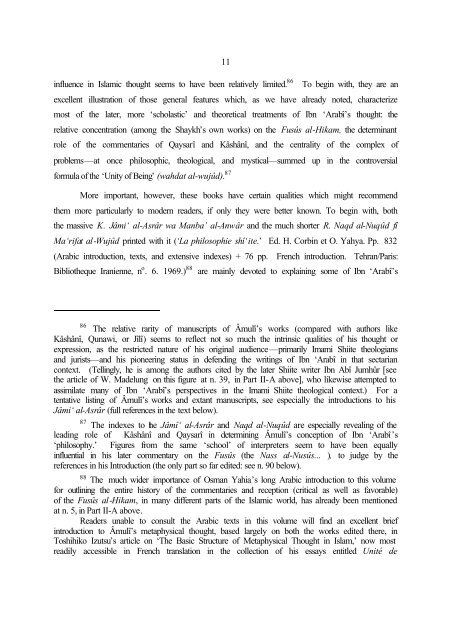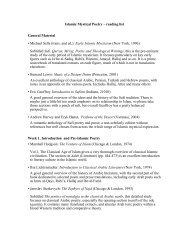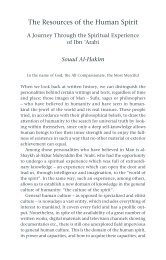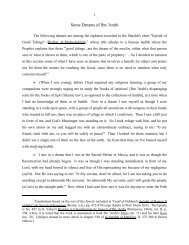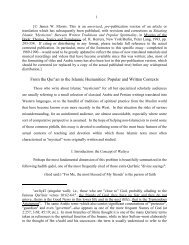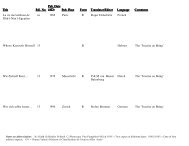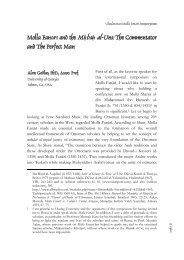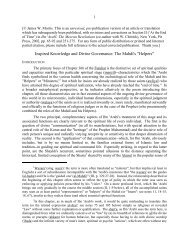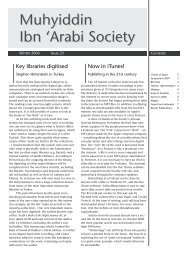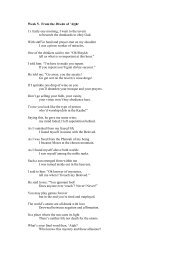Part III (pdf) - Muhyiddin Ibn Arabi Society
Part III (pdf) - Muhyiddin Ibn Arabi Society
Part III (pdf) - Muhyiddin Ibn Arabi Society
Create successful ePaper yourself
Turn your PDF publications into a flip-book with our unique Google optimized e-Paper software.
11influence in Islamic thought seems to have been relatively limited. 86 To begin with, they are anexcellent illustration of those general features which, as we have already noted, characterizemost of the later, more ‘scholastic’ and theoretical treatments of <strong>Ibn</strong> ‘Arabî’s thought: therelative concentration (among the Shaykh’s own works) on the Fusûs al-Hikam, the determinantrole of the commentaries of Qaysarî and Kâshânî, and the centrality of the complex ofproblems—at once philosophic, theological, and mystical—summed up in the controversialformula of the ‘Unity of Being’ (wahdat al-wujûd). 87More important, however, these books have certain qualities which might recommendthem more particularly to modern readers, if only they were better known. To begin with, boththe massive K. Jâmi‘ al-Asrâr wa Manba’ al-Anwâr and the much shorter R. Naqd al-Nuqûd fîMa‘rifat al-Wujûd printed with it (‘La philosophie shî‘ite.’ Ed. H. Corbin et O. Yahya. Pp. 832(<strong>Arabi</strong>c introduction, texts, and extensive indexes) + 76 pp. French introduction. Tehran/Paris:Bibliotheque Iranienne, n o . 6. 1969.) 88 are mainly devoted to explaining some of <strong>Ibn</strong> ‘Arabî’s86The relative rarity of manuscripts of Âmulî’s works (compared with authors likeKâshânî, Qunawi, or Jîlî) seems to reflect not so much the intrinsic qualities of his thought orexpression, as the restricted nature of his original audience—primarily Imami Shiite theologiansand jurists—and his pioneering status in defending the writings of <strong>Ibn</strong> ‘Arabî in that sectariancontext. (Tellingly, he is among the authors cited by the later Shiite writer <strong>Ibn</strong> Abî Jumhûr [seethe article of W. Madelung on this figure at n. 39, in <strong>Part</strong> II-A above], who likewise attempted toassimilate many of <strong>Ibn</strong> ‘Arabî’s perspectives in the Imami Shiite theological context.) For atentative listing of Âmulî’s works and extant manuscripts, see especially the introductions to hisJâmi‘ al-Asrâr (full references in the text below).87 The indexes to the Jâmî‘ al-Asrâr and Naqd al-Nuqûd are especially revealing of theleading role of Kâshânî and Qaysarî in determining Âmulî’s conception of <strong>Ibn</strong> ‘Arabî’s‘philosophy.’ Figures from the same ‘school’ of interpreters seem to have been equallyinfluential in his later commentary on the Fusûs (the Nass al-Nusûs... ), to judge by thereferences in his Introduction (the only part so far edited: see n. 90 below).88The much wider importance of Osman Yahia’s long <strong>Arabi</strong>c introduction to this volumefor outlining the entire history of the commentaries and reception (critical as well as favorable)of the Fusûs al-Hikam, in many different parts of the Islamic world, has already been mentionedat n. 5, in <strong>Part</strong> II-A above.Readers unable to consult the <strong>Arabi</strong>c texts in this volume will find an excellent briefintroduction to Âmulî’s metaphysical thought, based largely on both the works edited there, inToshihiko Izutsu’s article on ‘The Basic Structure of Metaphysical Thought in Islam,’ now mostreadily accessible in French translation in the collection of his essays entitled Unité de


